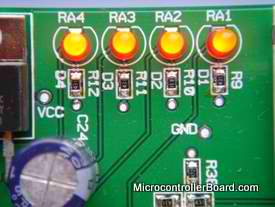EduPIC the PIC Microcontroller Board
EduPIC - PIC Microcontroller development (demonstration) board is an assembled circuit board for Microchip PIC16 and PIC18 microcontrollers (40-pin Dip socket).
The EduPIC board can be used for many types of electronic projects, development and application prototyping. In addition, it can be used for demonstration, training, and education purposes.
CLICK HERE to view microcontroller board - EduPIC schematic circuit
Who should use EduPIC development/demonstration board?
EduPIC development/demonstration board was designed to allow:
- Students of engineering
- R/D Engineers
- Microchip users
without difficulty implement and explore the capabilities of the PIC microcontrollers.
What is EduPIC development board designed for?

Figure: Four red LEDs connected to PORTA
The EduPIC development / demonstration board is designed for HANDS ON learning EXPERINCE how to program with Microchip PIC microcontroller.
In addition, EduPIC development / demonstration board is designed for EASY developing PIC microcontroller projects.
It ships with a 40-pin FLASH device PIC16F877A already installed. The user can change the device to other PIC16 or PIC18 40-pin DIP device.
The EduPIC development board is supplied with a FREE software package written in C language (based on HI-TECH compiler).
CLICK HERE to download the FREE software package (110KB)
What are the benefits of the EduPIC development board?
One of the unique benefits of the EduPIC development board is its RF capability. It has an option of a RF transmitter and a receiver built in. Additional benefits are:
- ease and simplicity of learning the EduPIC
- ease and simplicity of developing Microchip projects
- assembled circuit board
- low cost
- FREE source code (written in C language)
EduPIC Development Board Features
The following video is a quick summary overview of some features available with PIC microcontroller development board - EDUPIC.
The EduPIC demonstration board has the following hardware features:
- 40-pin Dip socket (PIC16F877A included)
Click here for PIC16F877A Data sheet - On board 5v regulator for direct input 9v/100ma AC/DC adapter.
- RS-232 associated hardware for direct connection to an RS-232 interface.
- In-Circuit Debugger (ICD) connector.
- 5 (kΩ) pot connected to analog input.
- Three push button switches, two for external stimulus and one for Reset.
- Power-on indicator Led.
- Four red LEDs connected to PORTA.
- 4 Mhz crystal oscillator.
- 32K x 8 Serial EEPROM.
- Serial DAC with 8 bit resolution.
- 2 x 16 LCD Display.
- Piezo buzzer.
- AM Receiver and Transmitter prototypes for establishing wireless connection.
- 4 x 4 Keyboard connected to PORTB(4bits) and PORTD(4bits).
- USB associated hardware for direct connection to USB interface.
- CAN-BUS interface (optional).
- Prototype area for user connections.
- Two 8 bit Q-Switches for electrical isolating and external connection of user area to the MCU.
A comparison between EduPIC and PICDEM 2 Plus boards
| Features | EduPIC board | PICDEM 2 Plus Board |
| Dip socket | 40 pin | 18, 28, 40 pin |
| Works off of a battery | NO | YES |
| RS-232 associated hardware | YES | YES |
| In-Circuit Debugger (ICD) connector | YES | YES |
| Serial EEPROM | YES | YES |
| # of push button switches | 3 | 3 |
| Power-ON indicator led | YES (green led) | YES (green led) |
| # of LEDs | 4 | 4 |
| Crystal oscillator | 4Mhz | 4Mhz |
| 2x16 LCD Display | YES | YES |
| Piezo buzzer | YES | YES |
| RF capabilities | YES | NO |
| 4 x 4 Keyboard | YES | NO |
| Prototype area | YES | YES |
| FREE Programs | Written in C language | Written in ASSEMBLY |
| Temperature sensor | NO | YES |
| Price | $129 | $99 |
Minimum System Requirements:
- Pentium 100MHz
- USB port
- 2 Megabytes of hard drive space
- 16 Megabytes of RAM
- Windows NT/2000/XP/Vista
Supported PIC Microcontrollers
Currently EduPIC development board supports the following devices:
- PIC16 family (40-pin Dip socket)/li>
- PIC18 family (40-pin Dip socket)